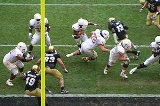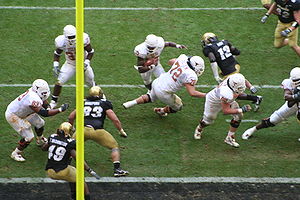
Touchdown
Encyclopedia

American football
American football is a sport played between two teams of eleven with the objective of scoring points by advancing the ball into the opposing team's end zone. Known in the United States simply as football, it may also be referred to informally as gridiron football. The ball can be advanced by...
and Canadian football
Canadian football
Canadian football is a form of gridiron football played exclusively in Canada in which two teams of 12 players each compete for territorial control of a field of play long and wide attempting to advance a pointed prolate spheroid ball into the opposing team's scoring area...
. Whether running, passing
Forward pass
In several forms of football a forward pass is when the ball is thrown in the direction that the offensive team is trying to move, towards the defensive team's goal line...
, returning a kickoff
Kickoff (American football)
A kickoff is a method of starting a drive in American football and Canadian football. Typically, a kickoff consists of one team – the "kicking team" – kicking the ball to the opposing team – the "receiving team"...
or punt
Punt (football)
In some codes of football, a punt is a play in which a player drops the ball and kicks it before it touches the ground. A punt is in contrast to a drop kick, in which the ball touches the ground before being kicked....
, or recovering a turnover, a team scores a touchdown by advancing the ball into the opponent's end zone
End zone
In gridiron-based codes of football, the end zone refers to the scoring area on the field. It is the area between the end line and goal line bounded by the sidelines. There are two end zones, each being on an opposite side of the field...
.
Description
To score a touchdown, one team must take the footballFootball (ball)
A football is an inflated ball used to play one of the various sports known as football.The first balls were made of natural materials, such as an inflated pig bladder, sometimes inside a leather cover...
into the opposite end zone
End zone
In gridiron-based codes of football, the end zone refers to the scoring area on the field. It is the area between the end line and goal line bounded by the sidelines. There are two end zones, each being on an opposite side of the field...
. The touchdown is scored the instant the ball crosses the plane
Plane (mathematics)
In mathematics, a plane is a flat, two-dimensional surface. A plane is the two dimensional analogue of a point , a line and a space...
of the goal line—that is, any part of the ball is in the space on, above, or across the goal line—while in possession of a player whose team is trying to score in that end zone. The play is dead and the touchdown scores the moment the ball crosses the goal line in possession of a player, or the moment the ball comes into possession of an offensive player in the end zone (having established possession by controlling the ball and having one or both feet or another part of the body on the ground). The slightest part of the ball being over the goal line is sufficient for a touchdown to score. However only the ball—not a player's helmet, foot, or other part of the body—counts. Touching one of the pylons at either end of the goal line with the ball constitutes "breaking the plane" as well.
Touchdowns are usually scored by the offense by running
Rush (American football)
Rushing has two different meanings in gridiron football .-Offense:The first is an action taken by the offensive team that means to advance the ball by running, as opposed to passing. A run is technically any play that does not involve a forward pass...
or passing
Forward pass
In several forms of football a forward pass is when the ball is thrown in the direction that the offensive team is trying to move, towards the defensive team's goal line...
the ball. However, the defense can also score a touchdown if they have recovered a fumble
Fumble
A fumble in American and Canadian football occurs when a player, who has possession and control of the ball loses it before being downed or scoring. By rule, it is any act other than passing, kicking or successful handing that results in loss of player possession...
or made an interception and return it to the opposing end zone. Special teams can score a touchdown on a kickoff
Kickoff (American football)
A kickoff is a method of starting a drive in American football and Canadian football. Typically, a kickoff consists of one team – the "kicking team" – kicking the ball to the opposing team – the "receiving team"...
or punt return, or on a return after a missed or blocked field goal
Field goal (football)
A field goal in American football and Canadian football is a goal that may be scored during general play . Field goals may be scored by a placekick or the now practically extinct drop kick.The drop kick fell out of favor in 1934 when the shape of the ball was changed...
attempt or blocked punt
Punt (football)
In some codes of football, a punt is a play in which a player drops the ball and kicks it before it touches the ground. A punt is in contrast to a drop kick, in which the ball touches the ground before being kicked....
. In short, any play in which a player legally carries the ball across the goal line scores a touchdown, the manner in which he gained possession is inconsequential. In the NFL, a touchdown may be awarded by the referee as a penalty for a "Palpably Unfair Act" such as a player coming off the bench during a play and tackling the runner who would otherwise have scored.
A touchdown is worth six points. The scoring team is also awarded the opportunity for an extra point
Extra Point
Extra Point is a twice-daily, two-minute segment on ESPN Radio that covers generic sports-related topical news and opinion. The AM edition airs Monday through Saturday at various times between 6 a.m. and 10 a.m. ET, and the PM edition airs Monday through Friday between 3 p.m. and 7 p.m. ET...
or a two-point conversion
Two-point conversion
In American and Canadian football, a two-point conversion is a play a team attempts instead of kicking a one-point convert immediately after it scores a touchdown...
. Afterwards, the team that scored the touchdown kicks off
Kickoff (American football)
A kickoff is a method of starting a drive in American football and Canadian football. Typically, a kickoff consists of one team – the "kicking team" – kicking the ball to the opposing team – the "receiving team"...
to the opposing team, if there is any time left.
Unlike a try
Try
A try is the major way of scoring points in rugby league and rugby union football. A try is scored by grounding the ball in the opposition's in-goal area...
scored in rugby union
Rugby union
Rugby union, often simply referred to as rugby, is a full contact team sport which originated in England in the early 19th century. One of the two codes of rugby football, it is based on running with the ball in hand...
or rugby league
Rugby league
Rugby league football, usually called rugby league, is a full contact sport played by two teams of thirteen players on a rectangular grass field. One of the two codes of rugby football, it originated in England in 1895 by a split from Rugby Football Union over paying players...
, and contrary to the event's name, the ball does not need to touch the ground when the player and the ball is inside the end zone.
History
When the first uniform rules for American football were enacted by the newly-formed Intercollegiate Football Association just following the 1876 Rugby season, a touchdown counted for 1/4 of a kicked goal (except in the case of a tie) plus it allowed the offense the chance to kick for goal by placekick or dropkick from a spot along a line perpendicularPerpendicular
In geometry, two lines or planes are considered perpendicular to each other if they form congruent adjacent angles . The term may be used as a noun or adjective...
to the goal line and passing through the point where the ball was touched down, or through a process known as a "punt-out", where the attacking team would kick the ball from the point where it was touched down to a teammate. If the teammate could fair catch
Fair catch
A fair catch is a feature of American football and several other codes of football, in which a player attempting to catch a ball kicked by the opposing team – either on a kickoff or punt – is entitled to catch the ball without interference from any member of the kicking team...
the ball, he could follow with a try for goal from the spot of the catch, or resume play as normal (in an attempt to touch down the ball in a spot more advantageous for kicking). The governing rule at the time read: "A match shall be decided by a majority of touchdowns. A goal shall be equal to four touchdowns, but in the case of a tie, a goal kicked from [after] a touchdown shall take precedence over four touchdowns."
In 1881, the rules were modified so that a goal kicked from a touchdown took precedence over a goal kicked from the field in breaking ties.
In 1882, four touchdowns were determined to take precedence over a goal kicked from the field. Two safeties were equivalent to a touchdown.
In 1883, points were introduced to football, and a touchdown counted as 4 points. A goal after a touchdown also counted as 4 points.
In 1889, the provision requiring the ball to actually be touched to the ground was removed. A touchdown was now scored by possessing the ball beyond the goal line.
In 1897, the touchdown scored 5 points, and the goal after touchdown added an additional point.
In 1900, the definition of touchdown was changed to include situations where the ball becomes dead on or above the goal line.
In 1912, the value of a touchdown was increased to 6 points. The end zone
End zone
In gridiron-based codes of football, the end zone refers to the scoring area on the field. It is the area between the end line and goal line bounded by the sidelines. There are two end zones, each being on an opposite side of the field...
was also added. Before the addition of the end zone, forward passes caught beyond the goal line resulted in a loss of possession and a touchback. (The increase from 5 points to 6 did not come until much later in Canada, and the touchdown remained only 5 points there until 1956.)
The ability to score a touchdown on the point-after attempt (two-point conversion) was added to NCAA football in 1958, high school football in 1969, and the NFL in 1994.
See also
- Football scoring
- TryConvertThe convert or try, in American football known as "point after", and Canadian football "Point after touchdown", is a one-scrimmage down played immediately after a touchdown during which the scoring team is allowed to attempt to score an extra one point by kicking the ball through the uprights , or...
- Touchdown celebration
- Touchdown JesusTouchdown JesusTouchdown Jesus may refer to:*The Word of Life or Touchdown Jesus, a mural visible from Notre Dame Stadium.*King of Kings or Touchdown Jesus, a statue that was on the east side of Interstate 75 near Monroe, Ohio...

